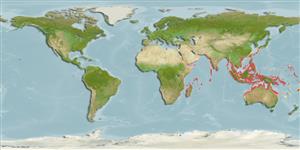Common names from other countries
Environment: milieu / climate zone / depth range / distribution range
Ecologia
marinhas demersal; intervalo de profundidade ? - 17 m (Ref. 11441). Tropical
Indo-West Pacific: India and Sri Lanka to western Thailand, Sumatra and the southern islands of Indonesia, and northwestern Australia.
Tamanho / Peso / Idade
Maturity: Lm ? range ? - ? cm
Max length : 15.0 cm SL macho/indeterminado; (Ref. 9774); common length : 10.0 cm SL macho/indeterminado; (Ref. 9774)
Espinhos dorsais (total) : 0; Raios dorsais moles (total) : 65 - 70; Espinhos anais: 0; Raios anais moles: 49 - 52. Body brownish, with 1 ocellus above and below lateral line and 1 ocellus on posterior third of straight section of lateral line. Many indistinct spots and blotches on body. Pectoral fin on ocular side with 11-12 soft rays (Ref 9774).
Found on the muddy and sandy bottoms of the continental shelf. Feeds on benthic organisms. Sold fresh and dried salted in markets.
Life cycle and mating behavior
Maturities | Reprodução | Spawnings | Egg(s) | Fecundities | Larvas
Distinct pairing (Ref. 205).
Nielsen, J.G., 1984. Bothidae. In W. Fischer and G. Bianchi (eds.) FAO species identification sheets for fishery purposes. Western Indian Ocean fishing area 51. Vol. 1. FAO, Rome. pag. var. (Ref. 3322)
Categoria na Lista Vermelha da IUCN (Ref. 130435)
CITES (Ref. 128078)
Not Evaluated
Ameaça para o homem
Harmless
Utilização humana
Pescarias: espécies comerciais; Aquário: Aquários públicos
Ferramentas
Relatórios especiais
Descarregue XML
Fontes da internet
Estimates based on models
Preferred temperature (Ref.
115969): 25.2 - 29.2, mean 28.5 (based on 2471 cells).
Phylogenetic diversity index (Ref.
82804): PD
50 = 0.5000 [Uniqueness, from 0.5 = low to 2.0 = high].
Bayesian length-weight: a=0.00741 (0.00343 - 0.01604), b=3.17 (3.00 - 3.34), in cm Total Length, based on LWR estimates for this Genus-body shape (Ref.
93245).
Nível Trófico (Ref.
69278): 3.5 ±0.37 se; based on food items.
Resiliência (Ref.
120179): Elevada, tempo mínimo de duplicação da população menor que 15 meses (Preliminary K or Fecundity.).
Fishing Vulnerability (Ref.
59153): Low vulnerability (10 of 100).
